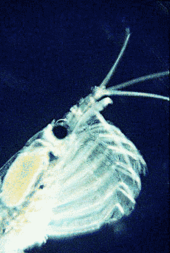
Back متغذ بالترشيح Arabic ফিল্টার ফিডার Bengali/Bangla Alimentació per filtració Catalan Filtrátor Czech Filtrator Danish Filtrierer German Filtromanĝanto Esperanto Alimentación por filtración Spanish Biofiltraatorid Estonian پالیدهخواری Persian

Filter feeders are aquatic animals that acquire nutrients by feeding on organic matters, food particles or smaller organisms (bacteria, microalgae and zooplanktons) suspended in water, typically by having the water pass over or through a specialized filtering organ that sieves out and/or traps solids. Filter feeders can play an important role in condensing biomass and removing excess nutrients (such as nitrogen and phosphate) from the local waterbody, and are therefore considered water-cleaning ecosystem engineers. They are also important in bioaccumulation and, as a result, as indicator organisms.
Filter feeders can be sessile, planktonic, nektonic or even neustonic (in the case of the buoy barnacle) depending on the species and the niches they have evolved to occupy. Extant species that rely on such method of feeding encompass numerous phyla, including poriferans (sponges), cnidarians (jellyfish, sea pens and corals), arthropods (krill, mysids and barnacles), molluscs (bivalves, such as clams, scallops and oysters), echinoderms (sea lilies) and chordates (lancelets, sea squirts and salps, as well as many marine vertebrates such as most species of forage fish, American paddlefish, silver and bighead carps, baleen whales, manta ray and three species of sharks—the whale shark, basking shark and megamouth shark). Some water birds such as flamingos and certain duck species, though predominantly terrestrial, are also filter feeders when foraging.